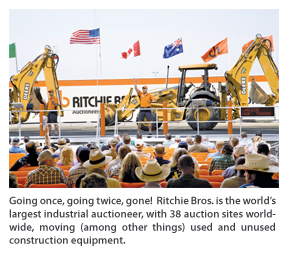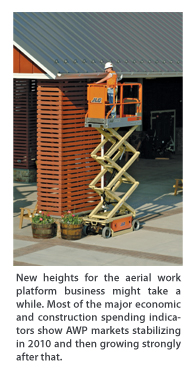Ebb and Flow of the Economy

The economic oceans continue to recede and expand. Many industries are certainly down (landscape, construction and manufacturing for instance), but others are still holding steady or even growing (agriculture, energy and healthcare for example). According to two new survey/reports released by the National Auctioneers Association (NAA) and the International Powered Access Federation (IPAF), the auction industry and the aerial work platform market are succeeding and struggling to overcome individual economic challenges.
The Highest Bidders
The calculating crew at the NAA, the nation’s leading association of auction professionals, reported in March the results of its 2008 industry survey. In 2008, approximately $268.4 billion in goods and services were sold at auction in the United States, a decrease of slightly less than 1 percent compared to 2007.

“The results of the industry survey are consistent with what we continually hear from auctioneers across the country. While some sectors of the industry have been impacted by the economy, others have grown or held strong,” said NAA president Randy Wells. “Consumers continue to attend auctions to find treasures and sellers continue to utilize professional auctioneers to help turn their assets into cash.”
Agricultural machinery and equipment auctions led the industry with gross sales revenue increasing 1.9 percent in 2008. The commercial and industrial machinery and equipment sector also witnessed growth last year. In addition to increased interest in auctions, growth in this sector can be associated with consumers choosing to purchase used equipment at auction, in place of buying new.
Headquartered in Overland Park, Kan., the National Auctioneers Association represents the interests of approximately 5,000 auctioneers in the United States, Canada and across the world. To learn more about auctions, find an auction or auctioneer, visit: www.auctioneers.org.
Lowering Aerial Outlooks
Things that go up usually end up coming back down. Aerial work platform-related revenues reached $8.8 billion in 2007 and are predicted to have fallen by 3 percent to $8.5 billion in 2008, according to the International Powered Access Federation (IPAF) U.S. Powered Access Rental Report 2008, released at the American Rental Association (ARA) Rental Show in Atlanta. The aerial work platform (AWP) rental business in the United States equates to about 35 percent of total revenue from the construction and industrial equipment rental market.

The report predicts that the current U.S. recession should end by late 2009, with shifts in the industry as residential and non-residential construction spending switch roles.
A broad recovery of AWP rental revenues is not expected to take place before 2011. On a positive note, most of the major economic and construction spending indicators show markets stabilizing in 2010 and then growing strongly after that.
Interestingly, the decrease of AWP rental revenues stemming from the lower demand is not expected to reduce the incidence of renting within the marketplace.
All factors considered, the report concludes that rental penetration rates will remain at high values and may even, depending on the overall economic development, increase. First, the AWP fleets of rental companies are much younger than those owned by contractors. When investments are cut and business confidence is low, companies will prefer to rent rather than buy new equipment. Second, the trend of specialization and technical progress favor modern rental fleets compared to older equipment, leading to a higher propensity to rent equipment. Thus, while the recession will lead to reduced demand for AWPs in the short term, rental penetration will remain resilient and stay at high levels or even increase. In other words, rental will get an increasing share of a decreasing pie.
Commenting on the report, IPAF managing director Tim Whiteman said: “In a difficult situation, it is ever more vital to have facts and figures to make sound strategic decisions. IPAF’s activities are growing in North America and this groundbreaking report is part of the support that we offer to members.”
The IPAF U.S. Powered Access Rental Report 2008 can be purchased for $235 (IPAF members) or $355 (non-members). To purchase the report, visit www.ipaf.org for details and the order form.

Comments are closed here.